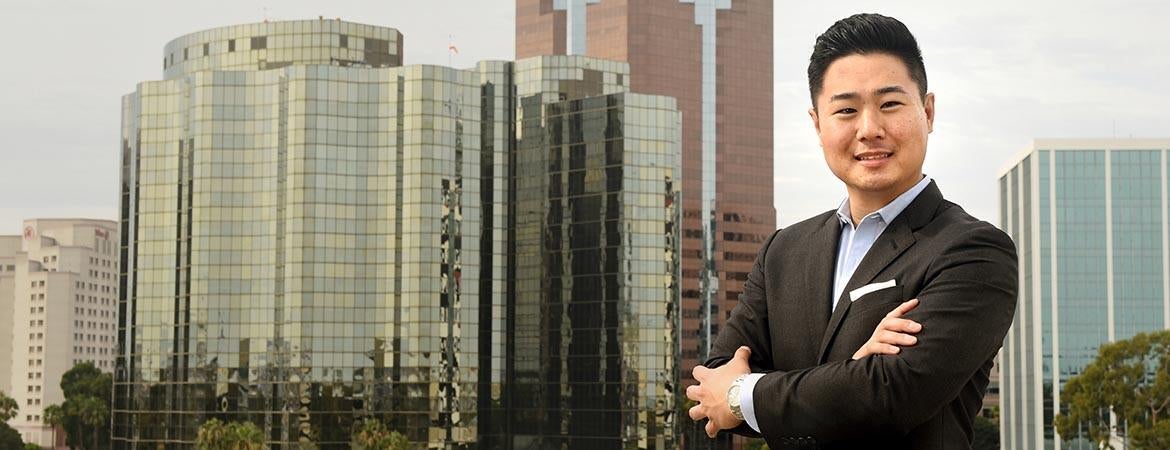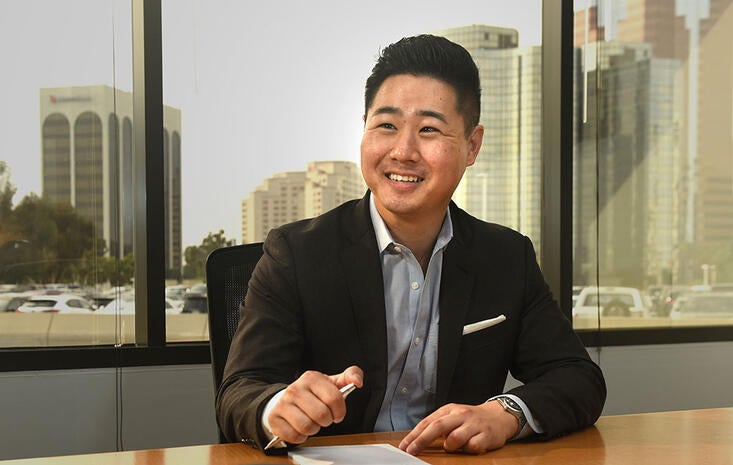
A UCR undergraduate business course on the stock market and valuations pointed Randolph Kim ’11, ’14 to his career. “That particular course led me to where I am today,” says Kim, who is the senior investment associate at TI Capital Management, a single-family office focused on private equity investments. “I find fascination in the art of investing and dealmaking and enjoy the challenges that come with it.”
Kim also earned a Master of Finance at UCR in 2014, and he was one of the student founders of the School of Business’s Hylander Financial Group, a student organization that dives into the world of investments, and he remains connected with these student investors. “I try to give back and offer guidance or insight to new and upcoming graduates, and I get to see the progress in their careers,” he says.
Finding Finance and Choosing a Career
Growing up, says Kim, he had a curiosity for how things worked. “One area that I could never fully get my head around were the public equities markets. Everything I saw and heard regarding the stock market was that it was some form of gambling or that charts and patterns of stock prices will predict and tell you where those prices are going.” That course on the stock market and valuations brought it all home for him, he adds, along with a couple of books that made an impression, including One Up on Wall Street by Peter Lynch.
“That course was the revitalization and genesis of my desire to work in investment finance on the buyside.”
When Kim decided to go to grad school, he chose UCR for two reasons: First, he had a great undergrad experience; second, the one-year Master of Finance was focused on fundamentals and valuations.
“The program was a nice mix of both the art and quantitative side of investing,” he says. “In fact, having gone over obscure off-balance-sheet financing items in the Financial Statement Analysis course, I was able to give an analysis in an onsite case study interview and caught a key component in the valuation model that the senior analyst had overlooked.
“I believe it was that attention to detail in my interviews that led both the equity research team and investment banking team, which I was not directly interviewing for, to extend me an offer. That moment was another turning point in my career that I have to give credit to UCR.
“My education equipped me to continue my personal studies, build experience, and eventually led me on to work at a long/short equity hedge fund and now at a single-family office covering private equity, venture capital, and real estate investments.”
Outperformance vs. Benchmark
At TI Capital, the investment team is made up of eight people. “I focus my time on private equity and venture investments, but because we’re a small office, I wear other hats and help run and oversee a couple of the real estate projects and public investment accounts,” says Kim.
Previously, Kim worked at the hedge fund with deep ties with the Lululemon family. “Through that experience, I understood the benefits of running family office money as it is sticky and patient money, and many times, had loose or no investment mandates,” he says. “While this capital is nice, the challenge with many family offices is that they tend to look at absolute performance.”
For example, he says, if you look at a year like 2022, it does not matter if you take pre-emptive action and asset allocation to increase cash holdings and show a -12% YTD return versus the S&P 500 at -18%., which is a relative 33% outperformance.
“The principal is looking at the numbers and seeing a 12% loss,” says Kim. “Save for a few specific strategies, such as income strategies, the principal is expecting strong outperformance versus benchmark.
Kim says the interesting thing about being in a family office without a set investment mandate is the sheer amount and variety of deal flow. “We look at deals of all types, from oil drilling joint ventures to maritime shipping to SaaS [software as a service] to agricultural land development. It is never a dull day in the office, and I am constantly meeting interesting founders and learning something new.”
A Healthy Professional Network
Kim also intentionally maintains a professional network of colleagues and attends investment conferences and dinners to establish new relationships and reconnect with old ones. “There are several family-office networks, and I am part of one that hosts quarterly dinners presenting a handful of the best ideas that have come across during that quarter,” he says. “I have met many capital groups and dozens of family offices through these events, and most of our deal flow comes through these personal connections.
“By having a growing and varied pool of relationships, I have introduced and connected founders, early career seekers, and investors.”
This type of outreach—to current students, fellow alumni, and business colleagues—is an integral part of expanding a career, says Kim. “The UCR alumni network is also large and varied, and I am able to find and reach out to several people who are in similar or parallel career tracks.
“It takes on a positive flywheel effect as these new relationships lead to additional introductions, business ventures, investment opportunities, and friendships.”
________________
Photo Credit: (c) Milka Soto
